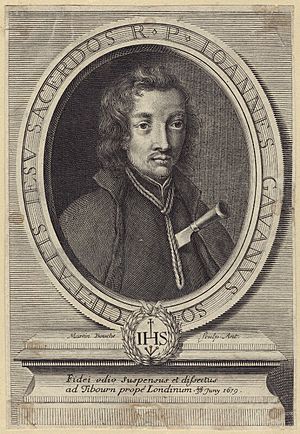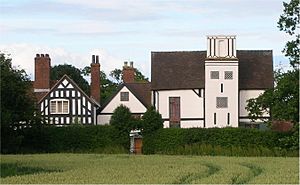John Gavan facts for kids
Quick facts for kids BlessedJohn Gavan SJ |
|
|---|---|

Engraving of John Gavan, SJ by Martin Bouche in the National Portrait Gallery
|
|
| Martyr | |
| Born | c.1640 London, England |
| Died | 20 June 1679 (aged 38–39) Tyburn, London, England |
| Honored in | Roman Catholic Church |
| Beatified | 15 December 1929, Rome by Pope Pius XI |
| Feast | 20 June |
John Gavan (1640–20 June 1679) was an English Jesuit priest. He was a victim of a made-up story called the Popish Plot. He was wrongly put to death for supposedly planning to kill King Charles II. In 1929, he was honored as "Blessed" by Pope Pius XI.
Contents
The Story of John Gavan
Early Life and Priesthood
John Gavan was born in London, England, around 1640. His family came from a place called Norrington. He went to school at Jesuit colleges in St. Omer's, Liège, and Watten.
He became a priest in 1670. He worked in Staffordshire, a county in England. Many Roman Catholic people lived there. People sometimes called him "the Angel" because he was so kind.
A Dangerous Time
On August 15, 1678, John Gavan made his final promises to join the Society of Jesus. This happened at Boscobel House. This house was famous because King Charles II hid there in 1651. He was hiding after losing a battle.
Two other priests, William Ireland and Richard Gerard, were also there. After the ceremony, everyone had dinner. Then, they looked at the Royal Oak. This was the tree where the King had hidden.

This celebration later caused big problems for John Gavan. It also affected William Ireland and Richard Gerard. A man named Stephen Dugdale heard about the gathering. He was an informer for the "Popish Plot."
The "Popish Plot" was a made-up story. It claimed that Catholics were planning to kill the King. Dugdale falsely said that the meeting at Boscobel was a plan to harm the King.
Arrest and Imprisonment
For a while, John Gavan was safe. The main inventor of the plot, Titus Oates, did not know him. But in January 1679, the government offered a reward for Gavan's arrest. This was after Dugdale gave his false information.
Gavan went to London to hide. He found safety at the Imperial Embassy. This was like a special building for another country. People tried to help him leave England secretly.
But a spy told the authorities where he was. John Gavan was arrested on January 29. The ambassador did not protect him. This was because Gavan was arrested in the embassy's stables. This area was technically outside the main embassy building.
The Trial
John Gavan was put on trial on June 13, 1679. Four other priests were tried with him. These were Thomas Whitbread, John Fenwick, William Barrow, and Anthony Turner.
Seven judges heard their case. The main judge was Sir William Scroggs. He strongly believed in the Popish Plot. He also disliked Catholic priests.
John Gavan spoke for all five accused men. He defended them very well. He was known as a very smart priest. He tried to show that Titus Oates was lying. Oates claimed to be in London at certain times. But Gavan showed Oates was actually at St. Omer's.
However, the judges said that Catholic witnesses might lie. They claimed Catholics could get special permission to lie under oath. So, the judges said Catholic witnesses were less trustworthy.
Gavan was better at showing problems in Oates's own story. Oates could not explain why he had not accused Gavan earlier. Gavan ended his defense with a strong speech. He said he was innocent. The judge, Scroggs, kept interrupting him.
The Verdict and Execution
When the judge spoke to the jury, he admitted he had forgotten some details. But he made it clear he wanted a guilty verdict. The jury quickly found all five men guilty. They were sentenced to death the next day.
John Gavan and the others were hanged on June 20, 1679. This happened at a place called Tyburn. Many people watched. It seemed that public opinion was changing. People were starting to feel sorry for the victims.
Witnesses said the crowd was very quiet. Each man spoke for about an hour. They all said they were innocent. Finally, Gavan led them in a prayer. His last words were, "I am content to undergo an ignominious death for the love of you, dear Jesus."
King Charles II believed they were innocent. But he worried about public anger. So, he did not pardon them. However, he showed some kindness. He ordered that they be allowed to hang until they died. This meant they would not suffer the full, terrible punishment of being drawn and quartered. They were buried in a churchyard in London.

